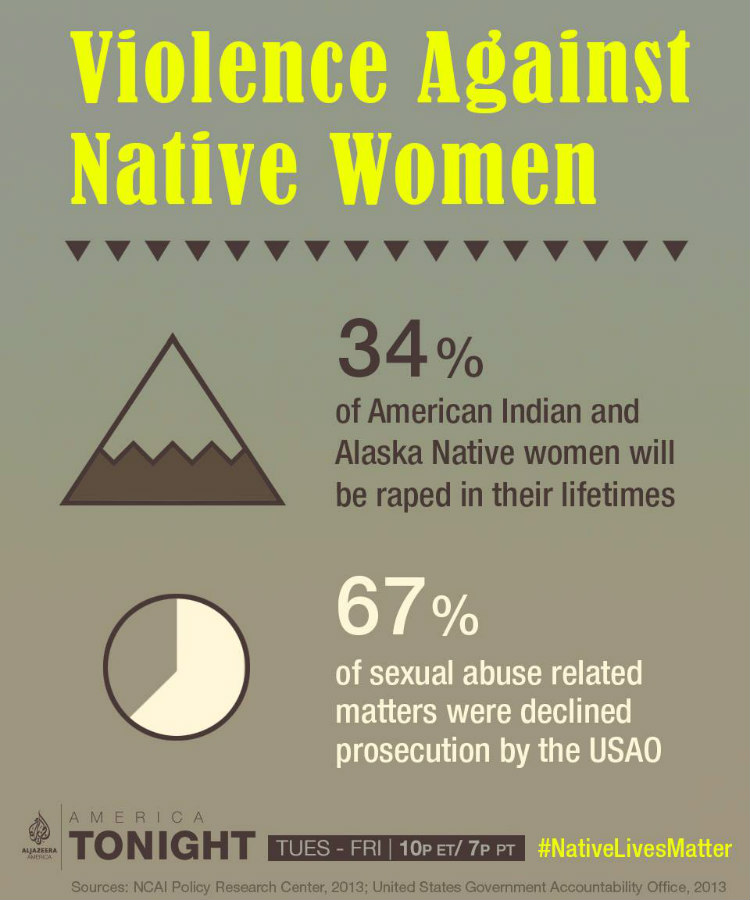Violence Against Native American Women
Native American Women face disproportionate amounts of violence, especially sexual violence, to their American counterparts. They are raped at shockingly higher rates than women of any other race in America. These perpetrators have been both Native Americans and non-Native Americans. Instituting proper jurisdiction in tribal courts, improving policing systems, and re-establishing inherent respect of minority women can be used to help solve this issue.
NGOs working on the issue
- National Indigenous Women’s Resource Center
- The Native American Women’s Health Education Resource Center (NAWHERC)
Sources to Consult
Ideas for helping out with the issue
- Donate to Native American Women’s Health Education Resource Center, attend events listed
Estrada, Antonio. (2017). Native American Medicine and Wellness. Class at University of Arizona. This source is a professor who lectures on Native American Medicine and Wellness and has worked extensively on matters regarding indigenous people. His course, taught at the University of Arizona, dives into not only the violence that Native American women endure but also the poverty, lack of education, health care, and historical trauma this group has faced. His perspective and experience offers insight on the community. “Violence Against Native Women Violates Human Rights.” Violence Against Native Women Violates Human Rights | Staging – ILRC, indianlaw.org/safewomen/humanrights. http://indianlaw.org/safewomen/humanrights “Promoting Human Rights for Native Americans – NARF.” Native American Rights Fund, www.narf.org/our-work/promotion-human-rights/. http://www.narf.org/our-work/promotion-human-rights/ Walker, Tate. “8 Top Social Media Conversations, Starting With #RockYourMocs.”Featured News, www.nativepeoples.com/Native-Peoples/November-December-2014/Going-Social/. http://www.nativepeoples.com/Native-Peoples/November-December-2014/Going-Social/ Casselman, Amy L. Injustice in Indian Country Jurisdiction, American Law, and Sexual Violence against Native Women. Peter Lang, 2016. http://ebookcentral.proquest.com/lib/uaz/detail.action?docID=4322678 Moritz, A. F. “Native Woman by A. F. Moritz.” Poetry Foundation, Poetry Foundation, www.poetryfoundation.org/poems/46180/native-woman. https://www.poetryfoundation.org/poems/46180/native-woman “History of the Native American Rights Fund.” Native American Rights Fund, www.narf.org/about-us/history/. http://www.nativeshop.org/ GlobalPovertyProject. “Native Women Talk Sex Trafficking.” YouTube, YouTube, 22 Mar. 2017, www.youtube.com/watch?v=KyeJuEfXA7w. https://www.youtube.com/watch?v=KyeJuEfXA7w This video comes face to face with a Native American woman who was once heavily involved and reliant on the sex trafficking lifestyle. She reveals her story, how she became involved in the first place and the inescapable reality she lived. Also featured in the video is a Native American advocate and provides a different opinion on the matter. Not only do you see the woman who was personally affected by this but also, someone who shares why this occurs to these women and the fact that she is far from alone in this endeavor. “Congress Reauthorizes Violence Against Women Act Extending New Tribal Provisions to Only Some of the Nation’s Tribes.” Native American Rights Fund, 20 Jan. 2015, www.narf.org/2013/03/congress-reauthorizes-violence-against-women-act-extending-new-tribal-provisions-to-only-some-of-the-nations-tribes/. http://www.narf.org/2013/03/congress-reauthorizes-violence-against-women-act-extending-new-tribal-provisions-to-only-some-of-the-nations-tribes/ This article discusses how the US House of Representatives passed the Senate’s reauthorization of the Violence Against Women Act (VAWA). A new provision allows tribal governments to prosecute non-Indian defendants who assault Native American women on tribal lands. Unfortunately, this provision does not extend to the 228 tribes in Alaska. Deer, Sarah. Sharing Our Stories of Survival Native Women Surviving Violence. AltaMira Press, 2008. This source portrays the survivors of sexual violence speaking out about their experiences. As the description states, the stories are far from sugarcoated but instead, reveal the brutal truth these women have endured. I think this testimonial is beneficial because these women can offer an insight of the violence rather than a third party looking in and making assumptions regarding a situation that hasn’t personally affected them. Entmacher, Joan, et al. “Insecure & Unequal Poverty and Income among Women and Families 2000-2012.” NWLC, Sept. 2013, www.nwlc.org/wp-content/uploads/2015/08/final_2013_nwlc_povertyreport.pd. https://www.nwlc.org/wp-content/uploads/2015/08/final_2013_nwlc_povertyreport.pdf Smith, Andrea. “Not an Indian Tradition: The Sexual Colonization of Native Peoples.”Welcome to Racial Equity Tools • Racial Equity Tools, Sept. 2003, www.racialequitytools.org/. http://www.racialequitytools.org/resourcefiles/NotIndianTradition.pdf This source points out how sexual violence is an intersectional issue that is a form of violence based not only on gender but also race. Women of color, such as Native American Women face more barriers than the sexual violence alone; for example, “less media attention, language barriers, and lack of support in the judicial system.” “Maze of Injustice.” Amnesty International USA, 2007, www.amnestyusa.org/. https://www.amnestyusa.org/pdfs/mazeofinjustice.pdf This report publishes the research conducted by Amnesty International USA (AIUSA) alongside Native American and Alaska Native organizations. The research is based on interviews with Native American sexual assault survivors, their families, health and aid workers, US government officials, and lawyers who represent those bringing their cases to court. Some of the issues the report touches on are other forms of discrimination, failures to respond, inadequate policing, and tribal courts. Gomez-Schempp, Cindy. “Social Justice.” Pinterest, 19 July 2014, www.pinterest.com/pin/313633561523366144/. https://www.pinterest.com/pin/313633561523366144/ This social media page is a tribute to empowered Native American women and the feminist movements that support them. It has photos of female leaders in Native American communities, “memes” poking fun at some of the ridiculous underestimating of the abuses Native American women have endured, and resources for women in these communities. Deer, Sarah. The Beginning and End of Rape: Confronting Sexual Violence in Native America. S.n., 2015. The Beginning and End of Rape: Confronting Sexual Violence in Native America “Lifetime Physical and Sexual Abuse, Substance Abuse, Depression, and Suicide Attempts among Native American Women.” AAHD, www.aahd.us/abstract/lifetime-physical-and-sexual-abuse-substance-abuse-depression-and-suicide-attempts-among-native-american-women/. Gilpin June 7, 2016 Print Share Subscribe Donate Now, Lyndsey. “High Country News.” Why Native American Women Still Have the Highest Rates of Rape and Assault, 7 June 2016, www.hcn.org/articles/why-native-american-women-still-have-the-highest-rates-of-rape-and-assault. http://www.hcn.org/articles/why-native-american-women-still-have-the-highest-rates-of-rape-and-assault This article highlights the shocking statistics regarding violence against Native American women. However, the source then goes a step further to examine why these shocking statistics pertain to them like the laws and those who enforce them unlike some of the other sources that we have examined. LexisNexis Academic: COMMENT: RESTORING THE VICTIM AND THE COMMUNITY: A LOOK AT THE TRIBAL RESPONSE TO SEXUAL VIOLENCE COMMITTED BY NON-INDIANS IN INDIAN COUNTRY THROUGH NON-CRIMINAL APPROACHES, North Dakota Law Review, Amber Halldin, 2008 This law review discusses how tribal courts’ jurisdiction over tribal lands has been diminished over the years. Additionally, it delves into how tribal courts deal with non-Indians who commit sexual assault on tribal land. Adequate resources and protections must be afforded to survivors of sexual violence so they can become thriving members of their community once again. “Break the Silence – 2 Step Competition OK.” At Comanche Nation Fair, Lawton, allevents.in/lawton/break-the-silence-2-step-competition-ok/719807871561626. https://allevents.in/lawton/break-the-silence-2-step-competition-ok/719807871561626 LexisNexis Academic: COMMENT: THE VIOLENCE AGAINST WOMEN ACT: A DOUBLE-EDGED SWORD FOR NATIVE AMERICANS, THEIR RIGHTS, AND THEIR HOPES OF REGAINING CULTURAL INDEPENDENCE, Saint Louis University Law Journal, Mary K Mullen, Summer 2017 “National Indigenous Women’s Resource Center.” National Indigenous Women’s Resource Center, 1 Oct. 1970, www.niwrc.org/. http://www.niwrc.org/ This source not only acknowledges the abundance of violence the Native American women face but also offers means to assist these women. This source directly works with Native American women with violence they face among many other issues related to this community. They provide a variety of events that promote others to become involved in helping these women as well as numerous resources for these women to utilize. Joe, Jennie Rose., and Francine C. Gachupin. Health and Social Issues of Native American Women. Praeger, 2012. **Inter Library Loan Key Facts: Lyndsey Gilpin June 7, 2016 Print Share Subscribe Donate Now. “High Country News.” Why Native American Women Still Have the Highest Rates of Rape and Assault, 7 June 2016, www.hcn.org/articles/why-native-american-women-still-have-the-highest-rates-of-rape-and-assault. http://www.hcn.org/articles/why-native-american-women-still-have-the-highest-rates-of-rape-and-assault “International Experts Say Ending Violence Against Indigenous Women Is Critical Step Towards Empowerment.” International Experts Say Ending Violence Against Indigenous Women Is Critical Step Towards Empowerment | National Indigenous Women’s Resource Center, 17 Mar. 2017, www.niwrc.org/news/international-experts-say-ending-violence-against-indigenous-women-critical-step-towards. http://www.niwrc.org/news/international-experts-say-ending-violence-against-indigenous-women-critical-step-towards LexisNexis Academic: COMMENT: THE VIOLENCE AGAINST WOMEN ACT: A DOUBLE-EDGED SWORD FOR NATIVE AMERICANS, THEIR RIGHTS, AND THEIR HOPES OF REGAINING CULTURAL INDEPENDENCE, Saint Louis University Law Journal, Mary K Mullen, Summer 2017 Intercontinental.Cry. “Colonialism, Genocide, and Gender Violence: Indigenous Women.”Intercontinental Cry, 17 Nov. 2007, intercontinentalcry.org/colonialism-genocide-and-gender-violence-indigenous-women/.
Testimonials
Deer, Sarah. Sharing Our Stories of Survival Native Women Surviving Violence. AltaMira Press, 2008.

